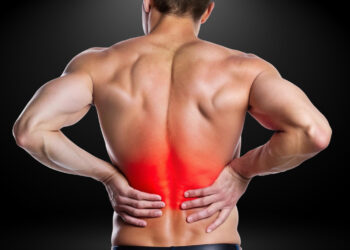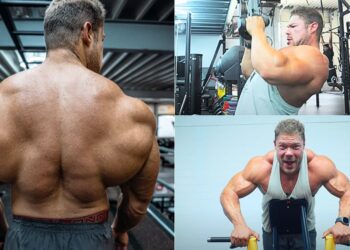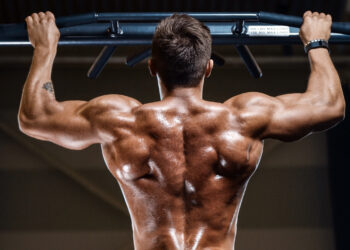Lower back pain is a painful and inconvenient issue that affects millions of people whether temporarily or long-term.
And the several factors which are a common cause for lower back pain include physical ailments/imbalances, poor posture, bad lifting habits, etc.
But as an athlete, improving this issue is non-negotiable in order to continue performing at a high level (or performing at all for that matter).
And thankfully, most cases are workable.
So, let’s get into a little more detail about the common causes and how you can either prevent or improve your lower back pain.
Note: The following information is intended to be informational and helpful for some cases of lower back pain. But for more severe and prolonged cases, we highly advise seeking help from a medical professional who can more thoroughly examine you in the case of more serious causes.
Level Up Your Fitness: Join our 💪 strong community in Fitness Volt Newsletter. Get daily inspiration, expert-backed workouts, nutrition tips, the latest in strength sports, and the support you need to reach your goals. Subscribe for free!
4 Common Causes of Lower Back Pain
Improper lifting Technique
Improper lifting techniques will almost certainly result in lower back pain that you may not even feel while you’re performing a certain exercise. In fact, many times, you feel it the next day and this pain just continues to be present.
Combine improper technique with excessively heavy weight training, and you’ve got a serious problem which many don’t properly address, if at all.
And training with too much weight whether you’re lifting the weight from the floor (e.g. deadlifts), from the upper body (e.g. squats), or even overhead (e.g. snatch and other Olympic movements) is problematic.
And this is especially the case when the back is in a dangerous position combined with heavy (or even light to moderate) weight-bearing exercises.
But, excessively heavyweight loads even with proper form is not recommended either depending on the level of training experience.
Weight training must be done progressively to enable the body to adjust, but many people skip the steps and try to get to the top of the stairwell outright; which is a huge mistake.
Now, many people are either unaware of the fact that they’re lifting with bad form, or they simply lack the knowledge of how to lift safely.
So, this is a very important aspect of training that needs to be identified and corrected to alleviate or prevent the potential for agonizing lower back pain.
Weak Core/Hips
Weak core muscles will cause lower back pain simply due to the role these muscles play in supporting the spine and back. But thankfully, most people can simply implement exercises that will strengthen the core to solve this problem.
These are the core muscles and their functions…
- Rectus abdominis (center anterior muscles also known as the abdominals which are responsible for trunk flexion) (1)
- Transverse abdominals (deep core muscles responsible for compression and stabilization)
- External and internal obliques (responsible for trunk rotation and lateral flexion)
- Erector spinae (trunk extension)
- Multifidi (spine stability)
Then you have your hips flexors which can become very tight or weak from over flexing, therefore causing lower back pain. And common culprits for tightness are sitting too long which shortens and tightens the iliopsoas (psoas and iliacus) muscles that stabilize the spine. Not eccentrically stretching the hips enough is another issue, commonly seen in runners.
But there’s really a myriad of issues which can cause hip tightness due to poor lifestyle habits and structural imbalances.
Although, tightness isn’t the only cause of back pain here and stretching may not be the solution if your muscles are simply weak (we’ll show you how to tell shortly).
Weak hip flexors can be due to the fact that you’re not using them enough and/or performing exercises that allow the upper legs to elevate higher 90 degrees.
So, it’s important to note that if you’re suffering from weakness rather than tightness, stretching can make everything worse, including your back pain.
Weak glute medius
A weak glute medius muscle is also a common cause of back pain due to its function as a hip abductor. And this weakness/imbalance most commonly occurs from too much sitting, as well as unequal weight distribution while walking.
Research shows a correlation between a weak glute medius muscle/ glute tenderness and lower back pain. (2)
But it also doesn’t help that this is a naturally weak muscle and, in fact, the weakest of the lower body. Plus, a weak glute medius can cause knee issues if not corrected.
Poor Posture
If when you sit or stand you resemble the hunchback of Notre Dame, then there’s a good chance you are or at least have dealt with some lower (and mid-back) back pain.
And that’s because the stress of improper posture causes problems with not only the spine but the muscles and joints as well.
One study took 88 volunteers and had them performance posture correction exercises for 8 weeks. By the end, significant improvements were noted for lower, middle back pain, and shoulders. (3)
This is especially important to know if you live a primarily sedentary lifestyle whether that means your habits or even your work situation.
But do we really need research to prove this? Not really. If you tend to sit for long periods and/or have less than ideal posture, then you know.
Best Exercises For Lower Back Pain
The exercises which are best for strengthening the core for the benefit of preventing or helping lower back pain will involve those which target the transverse abdominals or deep core muscles. (4)
But if your hips are the cause, then we’ll show you some exercises to remedy this.
And if the glute medius is the problem, it’s fixable.
Here are some effective exercises you should be doing…
Core
The great thing about these core exercises is that you really should be doing them anyway for the awesome benefits.
Level Up Your Fitness: Join our 💪 strong community in Fitness Volt Newsletter. Get daily inspiration, expert-backed workouts, nutrition tips, the latest in strength sports, and the support you need to reach your goals. Subscribe for free!
Hanging leg raise
The hanging leg raise and its variations are excellent for developing the core. Leg raises variations are rather difficult but also some of the most effective by the same token.
The legs are often heavy enough without adding weight and this is a great convenience factor as well. But you never want to swing your body during a leg raise variation as this limits the full engagement of the core which is necessary to hit these deep muscles.
And you’d be focusing more on the hip flexors instead of primarily the core.
- Hang from the bar and with your knees bent, raise your legs up until both are above parallel while keeping your core tight. Slowly lower your legs to prevent the gaining of momentum.
Elbow-to-Knee Plank
Planks are truly a great exercise for improving your core strength. But the basic plank is really only effective for beginners which is ok in that case. However, most people who do planks regularly would benefit more from an advanced version.
And that’s where the elbow to knee really shines. This variation challenges anti-rotational stability and anti-extension, therefore, it’s an ideal movement for avoiding lower back issues.
- You’ll simply get into a basic plank position, and then alternate touching your elbow to your knee in an opposite-side fashion. For example, you’ll move your left elbow back and right knee forward until they touch. Then, you’ll move your right elbow back and left knee forward.
Pallof press
The Pallof press is one of the most underrated core exercises which not only improves stability and strength in the core, but the entire body is involved here including the posterior chain (a significant contributor to stability).
- The key to this exercise is to fight the rotational forces by using the core, posterior chain (backside of the body), and maintaining an upright posture.
Check out our Pallof press guide.
Hip flexors/Posture
To determine if you have tight hips, try the modified Thomas test shown below…
- Sit on the edge of a bench or flat surface to where your mid-thigh is hanging off then lie down on your back. Pull both legs all the way back so that your knees are bent and then let one leg drop back down. Make sure your entire back is in contact with the surface.
If your leg drops down and does not make contact with the surface, then you’re looking at some hip tightness. In this case, you can employ some stretches.
To determine if you have weak hips, try this test…
- While standing straight, lift one knee and pull it to your chest. Then let go and try to keep your knee higher than your hips. You can also place your foot up on a bench.
If you can maintain the knee above the hips then you’re likely not suffering from weak hip flexors. But if your leg drops shortly after, then the psoas and iliacus are weak since these are the muscles that allow you to maintain the hips in the above 90-degree position.
Exercises for tight and weak hip flexors
Ok, so now that you know what the issue is, here are a few exercises to correct them. These exercises are also helpful for posture since the hip flexors tie into postural issues.
Tight hip flexors
Exercise #1
- Get into a half-kneeling position (bottom position of a lunge) and keep your torso completely upright. Lean forward keeping the hips back and get a good stretch then repeat with the opposite leg.
Exercise #2
Here’s a video example…
- Lie face down on a bench or even your bed so that one leg is hanging off and the other is flat against the surface. Use your hands to grip or hold the surface then lift your torso up so that your back is extended. You should feel the stretch in your hips. Then turn to the other side and repeat.
Weak hip flexors
- Lift your leg onto a platform that allows your knee to be higher than your hips so that your foot is flat. Stand completely erect and perform leg lifts holding each rep as long as you can. Switch legs and repeat.
Glute Medius
Here are a few effective exercises for strengthening the glute medius if you have a weakness.
And how you can tell is if you have a hard time lifting your leg to the side, or if you stand on one leg and your hips drop.
Side plank hip abduction
This is a great exercise for the glute medius and you only need your own body weight.
- Get into a side plank position and raise your hips upward for reps. Turn and repeat on the opposite side.
Lateral leg raise
This is another easy option to start to improve strength in your glute medius. And all you need to do is raise each leg up to strengthen the glute medius for the desired number of reps.
- Perform 10-12 reps of lateral leg raises on each side.
Hip raise using a wall
- Another exercise you can perform is to stand next to a wall so that your shoulder is close to the wall. Place your arm on the wall for balance then lift the leg closest to the wall until parallel and then bend the knee so that your leg is at 90 degrees. Now, lift your hip up and toward the wall. Perform as many reps as you can.
Use a Weightlifting Belt
Using a weightlifting belt is very beneficial for preventing lower back pain because this handy tool is essentially like a second pair of abs that creates anterior support from the additional intra-abdominal pressure provided; which is necessary for keeping the core tight and spine stabilized for the big lifts. (5)
The torso must be as rigid and stiff as possible to pull off maximal lifts without injury.
But you only want to use a belt during maximal lifts because you don’t want to take away from the natural intra-abdominal pressure from the core.
Check out our top lifting belt picks and guide.
Final Thoughts
Lower back pain is never fun and it can really put a damper on your ability to train and perform up to par. But the good news is, most people can effectively implement certain exercises to prevent and even improve this debilitating back pain.
But first, you should know why you’re suffering and then you can take the best possible course of action to correct the issues.
We hope you found this information helpful and just remember that maintaining a healthy body requires regular maintenance like anything else you’d expect to keep functioning at an optimal level.









AwAwesome article! I suffered from back pain for many years until I discovered this simple trick that naturally healed my arthritis in just 10 minutes a day:trick